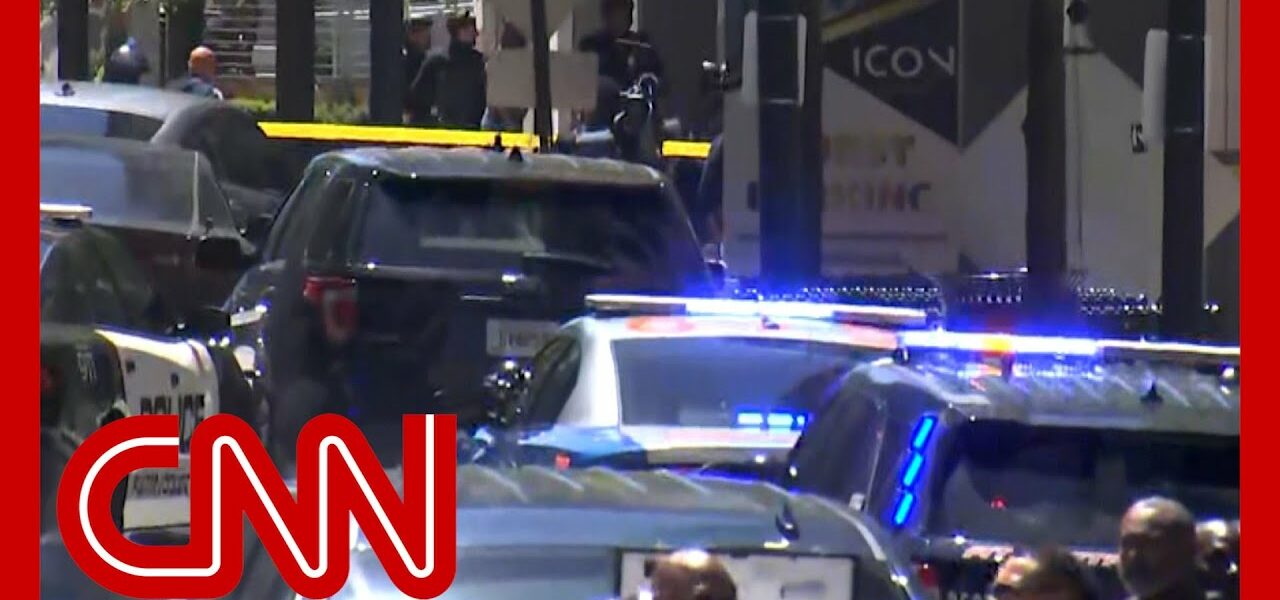One person is dead and four others have been taken to the hospital, the Atlanta Police Department said, as authorities continue to search for a gunman who they said shot multiple people at Northside Hospital Medical in Midtown. CNN's Ryan Young reports live from the scene. #CNN #News
Atlanta police report 1 dead, several injuries







Every gun should be registered to a certified owner, as in a well regulated militia, not a gun free for all.
Ask Japan@Greetings Earthlings! Pluto
Unfortunately, just another day in another democrat city.
@Randy Reynolds sounds like you know a lot about responsible gun ownership. How many guns per year do law enforcement ‘lose’ in the United States?
Well here we go again
Smh 😢
Everyday a new coward.
guns + more guns = even more guns
death + thoughts & prayers = still -1
tots and pears 🍟🍐🔫
@𝕵𝖆𝖘𝖔𝖓𝕾𝖕𝖊𝖈𝖍𝖙 Cool story, but praying isn’t exclusive to Christianity. Jesus isn’t my [nor many others’] “spiritual anchor”. Back to my point; a prayer will not bring back someone from the dead. Praying won’t stop bullets. Prayers alone will not prevent another Sandy Hook.
District attorneys. Mayors. City councils. Revolving door “justice”.
Unfortunately, just another day in another democrat city.
The daily, never ending consequences of never amending the 2nd Amendment for decades!
@Michael Ketcham Lots of people think for themselves and live by their own rules
@Michael Finnigan a gun never pointed itself at somebody and pulled the trigger… people did that
Unfortunately, just another day in another democrat city.
Only in America is it unsafe like this every day, everywhere.
Just blame trump it will make you feel better.
California especially. Businesses are fleeing and closing their doors
Unfortunately, just another day in another democrat city.
THIS IS WHY YOU KEEP CAPITAL PUNISHMENT. WE WANT SAFE NEIGHBORHOODS NOT COMFY CRIMINALS.
@Roe Jogan I agree 💯. Crime, however, has been empirically correlated to poverty and addiction ad nauseum, as has various mental and emotional indicators. Throwing money at these issues and traditional deterrents haven’t worked. Perhaps it’s time to switch focus as we’ve become a country tourists are afraid to travel to. 🤷🏾♀️
So there was no crime before capital punishment was abolished? Seems like someone somewhere would have analyzed crime stats in countries with capital punishment vs those without. I wonder if you could google them? 🤔
What’s going on 😭
Humanity is in great trouble
Because of your mom.
Unfortunately, just another day in another democrat city.
@Pablo Get your head out of Fox. Come into the light.
@Lamont Cranston CNN is the light? 😂😂😂
@rob cooke Happened in Serbia yesterday. Happens over the world all the time. Didn’t use to be like this.
0:36 timestamp is a doctored photo id I have ever seen one! What’s the real photo look like?
what evidence do you point to to make your assertion?
BS
Those trees look beautiful. It look like a nice day there.
At this point, I’m starting to think Americans aren’t praying hard enough. After yet another shooting, thoughts and prayers are offered, by now, they ought to do the trick
What should we do? Maybe we should elect a President that doesnt make life stressful via massive inflation
Idk why you are assuming praying works
@I_Am Wormwood He’s mocking the religious without understanding that when America actually was a religious country, this misbehavior and these shootings were incredibly rare.
The GOP extend ‘thoughts and prayers’ for everyone to buy more guns so they can get more donations from theNRA!
@Brian Holloway they would get crime down and that would save lives and specifically the victims in the inner city too.the NYC hearing wasn’t even aired on cnn or msnbc.
They said the people there were props and brought up trump the whole time.
I only hear them talk of mass shooting like this but not chicago mass shootings.they’re a different type I understand,but it should be looked at it instead of ignored
Just gfy
Unfortunately, just another day in another democrat city.
@Kahana Kahuna Yes.
It is not the case that the Second Amendment was intended to grant individuals the right to carry arms… On the contrary: The Second Amendment was never meant to have anything to do with individual gun rights.
The right argument for politicians to make on this issue — what’s both factually accurate and politically important — is that of Warren Burger. Burger was *a Republican who was appointed chief justice of the Supreme Court by President Richard Nixon in 1969* and served for 17 years until 1986. In retirement in 1991, Burger said that the Second Amendment _“has been the subject of one of the greatest pieces of_ *fraud,* _I repeat the word_ *FRAUD,* _on the American public by special interest groups that I have ever seen in my lifetime.”_
“The very language of the Second Amendment,” wrote Burger, “refutes any argument that it was intended to guarantee every citizen an unfettered right to any kind of weapon he or she desires. … The Framers clearly intended to secure the right to bear arms essentially for military purposes.”
Understanding this requires some knowledge of U.S. history, but not that much.
The 13 original U.S. states were first bound together by the Articles of Confederation, which were ratified in 1781 just as the American Revolution effectively ended. But the system didn’t work well, with the central government so weak that the “united” part of the United States was largely a joke.
An effort began, led by James Madison, to create a new governing structure. This eventually became the Constitution, which was drafted in Philadelphia in 1787. But then it had to be ratified by the states.
This was by no means a sure thing. One key point of contention between the Federalists who supported the Constitution and the Anti-Federalists who opposed it were concerns over a standing army. “Standing armies are dangerous to the liberties of a people,” the Anti-Federalists stated. “The truth of the position might be confirmed by the history of almost every nation in the world.” And the Constitution gave the prospective new federal Congress the power “to raise and support Armies.”
Madison did not claim this was not an issue. However, he argued in Federalist No. 46:
_The State governments, with the people on their side, would be able to repel the danger … citizens with arms in their hands, officered by men chosen from among themselves, fighting for their common liberties, and united and conducted by governments possessing their affections and confidence. It may well be doubted, whether a militia thus circumstanced could ever be conquered by such a proportion of regular troops._
Madison then pointed to the success of the American Revolution itself as proof of the effectiveness of militias against a regular army.
To assuage the concerns of those on the fence about the Constitution, Federalists in various states proposed that its ratification be linked to the adoption of amendments limiting the power of the federal government. This was crucial: As the National Archives explains it, “The Constitution might never have been ratified if the framers hadn’t promised to add a Bill of Rights.”
This was the context for the writing of the Second Amendment. The Bill of Rights was partially based on the 1776 Virginia Declaration of Rights. As the Library of Congress says, the Virginia Declaration was “uniquely influential” and “used by James Madison in drawing up the Bill of Rights.” Section XIII of the Declaration read:
_That a well regulated militia, composed of the body of the people, trained to arms, is the proper, natural, and safe defense of a free state; that standing armies, in time of peace, should be avoided as dangerous to liberty; and that, in all cases, the military should be under strict subordination to, and be governed by, the civil power._
The final language of the Second Amendment was, of course, “A *well regulated Militia,* being necessary to the security of a free State, the right of the people to keep and bear Arms, shall not be infringed.”
A straightforward interpretation of this history was generally observed for a long time. In a key 1939 Supreme Court case, United States v. Miller, two men had traveled across state lines with an unregistered shotgun with a shortened barrel in violation of the National Firearms Act of 1934. A lower court held that part of the Act was an unconstitutional violation of the Second Amendment. In refuting this, the court declared that the “obvious purpose” of the Second Amendment was “to assure the continuation and render possible the effectiveness of [state militia] forces. … It must be interpreted and applied with that end in view.”
In the legal world more generally, no law review article from 1888 (when they were first indexed) through 1959 ever concluded the Second Amendment guaranteed an individual right to a gun.
It’s only recently that the Supreme Court has veered toward its current view. In a key 2008 case, the court held that the meaning of “a well regulated Militia” was “all able-bodied men.” Hence it was unconstitutional for the government to prevent an individual from possessing a weapon even if it was “unconnected with militia service.”
*This perspective clearly requires bizarre mental gymnastics and a resolute commitment to ignoring basic historical facts. But that’s the bread and butter of the current Supreme Court.* To get a sense of where they fall on the political spectrum, it’s useful to compare their perspective to that of Jay Bybee, a judge on the 9th U.S. Circuit Court of Appeals. In a recent decision, Bybee wrote, “Our review of more than 700 years of English and American legal history reveals a strong theme: government has the power to regulate arms in the public square. … Indeed, we can find no general right to carry arms into the public square for self-defense.” Bybee is best known for signing off on the George W. Bush administration’s memos authorizing torture.
Meanwhile, away from the Supreme Court’s dense opinions, the case for eliminating limits on gun rights is simpler. On the wall of the lobby at the National Rifle Association’s headquarters in Virginia, you will read the stirring words “… the right of the people to keep and bear arms, shall not be infringed.” I.e., *the inconvenient beginning of the Second Amendment has been edited out.*
So Warren Burger was certainly right to say in 1991 that “the American people should have a firm understanding of the true origin and purpose of the Second Amendment.” But the unfortunate fact is that they definitely do not. The conservative faction of the Supreme Court likes it that way, and even top Democrats don’t seem inclined to explain it to anyone.
Oh and also i don’t think the democrats know too much any of the constitution and amendments sadly.alot of people dont now either.i know some but never pretend to know more than i do..a-lot of voters don’t research and know the facts that u put up uere
The right of THE PEOPLE to keep and bear arms SHALL NOT BE INFRINGED.
We are, we are…. the woke of the nation.
America.
Where men, women and children come to die horribly, suddenly, for absolutely no reason.
Thoughts and prayers.
Most Americans don’t die in shooting of any kind, though.
My condolences and we must stay close to god 🙏🏽👑
Lol.
How can’t that be found,the size of the lips have to be unique
Maybe we should elect a president and congress that doesn’t focus everything on on job killing regulation, government overreach, and sanctions that directly contribute heavily to inflation, making peoples lives better. Shoulda kept Trump
number of gun-related deaths in the U.S. (Pew Research Center)
39,707 in 2019 * 45,222 in 2020 * 48,830 in 2021 * 40,125 in 2022